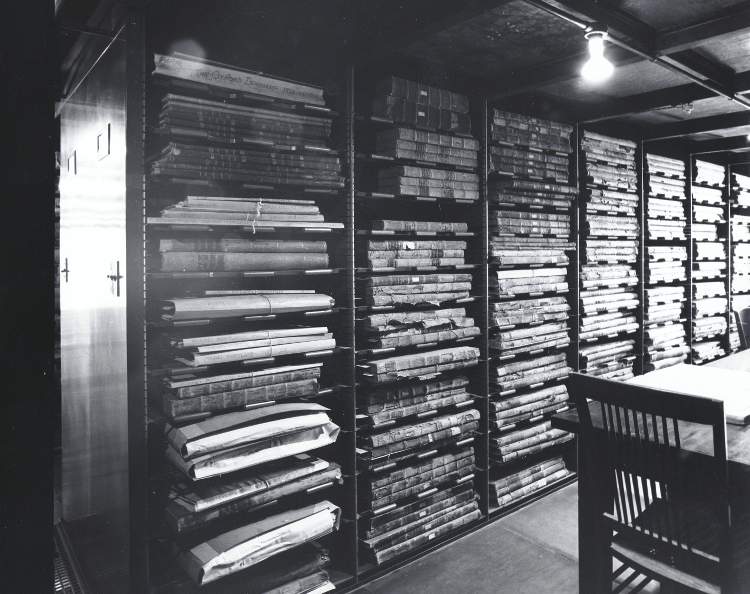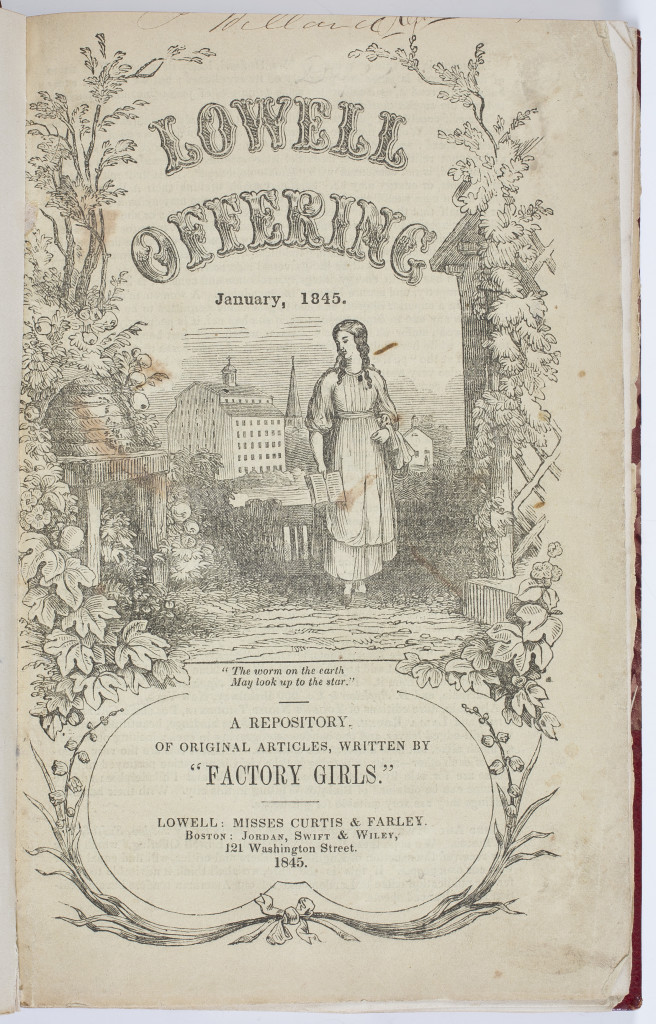Assistant Professor of English at University of Maryland Baltimore County Lindsay DiCuirci and our digital humanities curator, Molly O’Hagan Hardy, recently collaborated to combine early American labor history and digital humanities in the classroom.
It is with great pleasure that we introduce to you the latest Omeka exhibition from AAS: Mill Girls in Nineteenth-Century Print. We hope that you will find this site another innovative and exciting glimpse into our collections. The production of this site differed from our previous model, in which AAS staff served as exhibition curators. This time, AAS partnered with Lindsay’s advanced-level English seminar Women and American Periodicals at the University of Maryland Baltimore County, and the students themselves curated the exhibition. The students were given some basic Omeka instruction and the topic to investigate: depictions of young women working in factories in nineteenth-century magazines and newspapers. Through screencasts and videoconferencing with Molly, the students were also given a crash-course in metadata and how the rich metadata in the AAS Catalog could be transformed into their item descriptions. The students then researched the topic in various online and print sources, came up with an organizing schema for their exhibition, conferred on site design, selected the final pieces, wrote labels, and reflected on their work.
Lindsay crafted an assignment for the students that was at once detailed (in terms of expectations and deadlines) and at the same time gave them a lot of room for research discoveries and project building. We aimed to ensure the students’ full immersion into the curatorial process. Within a single semester, we wanted the students to experience the winnowing process inherent in any curatorial work, as well as the creativity afforded by and constraints imposed from a given content design platform. The students were told that the exhibition would draw upon the AAS holdings to highlight the powerful and often controversial presence of the female mill worker in American periodicals and newspapers. Ranging from romantic and whimsical depictions of the “factory girl” to stunning critiques of poor conditions, writings about women’s labor in America’s mills were ubiquitous in nineteenth-century magazines. Women of leisure were frequently confronted with stories, images, or representations of women at work. This juxtaposition, Lindsay explained to them, makes the study of mill girls in American periodicals and newspapers particularly fraught. The exhibition, the students were told, aimed to include a broad range of forms and genres, from editorials to poems to short stories to engravings, and a comprehensive range of periodicals from niche industry newspapers to national literary reviews.

Students were assigned weekly tasks across the fifteen-week semester, broken up into three major phases: initial archival research; selection and organization; writing and design. First, students focused on finding pieces relevant to the exhibition and generated a spreadsheet of over one hundred items.
From this large collection, they began to winnow the items and noted thematic patterns emerging in the materials. These patterns—culture, conditions, and activism—became the three main exhibits and students signed up to serve on an exhibit team. After Ken Albers visited UMBC’s campus to train the class on using Omeka, students began to refine their exhibit holdings and input them into a shared metadata spreadsheet. This became an essential tool through which the class and Molly could communicate about exhibition items. As students found primary sources on various digital databases, Molly would then locate the print source at AAS and request photography. Though at times students ran into roadblocks—items that were unavailable or didn’t fit the exhibition criteria—they continuously went back into the archive to find appropriate and accessible items for inclusion. In the last third of the semester, students drafted exhibition labels and, in teams, composed mini-essays for the exhibit landing pages. They collaborated on their writing and used opportunities both in and out class to make revisions. With the help of the AAS staff members who are also curating online Omeka exhibitions, Molly and Lindsay also developed a “Dos” and “Don’ts” handout to aid students in writing for digital platforms. Much of the design and page layout was finalized in the last two weeks of the semester. One of the graduate students, Ging Shamberger-Sandosky, designed the masthead image and a design sub-group made some layout and color scheme decisions using the CSS editor. Students were then asked to reflect on the process and identify their specific contributions in a three-page analytical reflection essay, submitted at the last class meeting.
The result:
 The results, we hope you will find, display the students’ impressive curatorial skill. After much debate and reflection, the students structured the topic around three major categories: mill girl culture, working conditions, and activism and reform. Each of these “exhibits” has subcategories with items from well-known nineteenth-century periodicals such as the Lowell Offering, but also lesser known ones such as the Man and the Southern Rose. The students also looked at the artistic expression of the workers and about their conditions: in ballads, poems, and songs. Though the exhibition highlights only primary sources, the students certainly read a lot of secondary material to prepare their labels. These and other relevant sources can be found in the “Further Reading” section of the exhibition.
The results, we hope you will find, display the students’ impressive curatorial skill. After much debate and reflection, the students structured the topic around three major categories: mill girl culture, working conditions, and activism and reform. Each of these “exhibits” has subcategories with items from well-known nineteenth-century periodicals such as the Lowell Offering, but also lesser known ones such as the Man and the Southern Rose. The students also looked at the artistic expression of the workers and about their conditions: in ballads, poems, and songs. Though the exhibition highlights only primary sources, the students certainly read a lot of secondary material to prepare their labels. These and other relevant sources can be found in the “Further Reading” section of the exhibition.
Students found this project both challenging and rewarding. Flexibility and problem solving proved to be two of the most essential skills in building the exhibition. The students almost universally remarked that the group collaboration was a highlight of the project. They also became more comfortable with the trial-and-error nature of this project as the semester wore on, learning to make adjustments and executive decisions and to rely on their peers’ knowledge when needed. Every student found his or her niche, whether in the area of research or writing, organization or design. One student remarked that working on the exhibit had taught her “more about research, group work, and productivity than any other experience thus far during [her] undergraduate career.” Students also observed that they had not known of the mill girls prior to their work on this project; their sense of the industrial revolution and early labor movements was vague. Many students observed similarities between laborers’ activism in the nineteenth century and today; for one student, the readings made her recognize that “working conditions have improved, but in other ways, we still need to change the way a woman’s work is valued and compensated.” This exhibition paints a multi-faceted picture of the mill girls, the sentimental subject of poems and songs and the agitators in a burgeoning reform movement.




2 thoughts on “Mill Girls in Nineteenth-Century Print: AAS Collections meet DH Pedagogy”